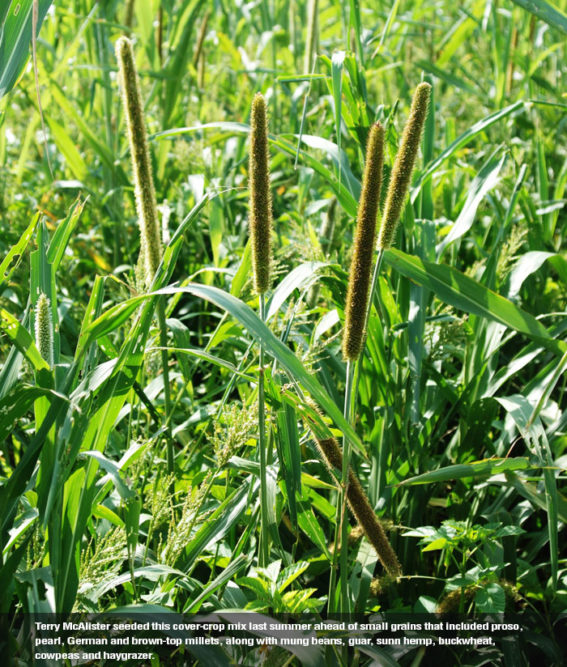Bias against cover cropping persists in parts of the country where drought and sparse rainfall are no strangers. Some growers feel incorporating cover crops into no-till systems can’t work because covers will use up all of the available moisture needed for the following cash crop.
But a panel of veteran no-tillers from across the Great Plains say the trade-offs with cover crops — including building soil organic matter and moisture-holding capacity — are worth it.
“We have some moisture issues with cover crops, but you have to take advantage when you get moisture and plant something. When we have moisture we need to use it, because there’s no way that we can store it for later,” Hugo, Colo., no-tiller Scott Ravencamp told more than 200 farmers who attending the recent Southern Soil Health Conference in Fort Worth, Texas.
Extra Income
Ravencamp and his uncle, Lyle Ravencamp, are managing partners for Ravencamp Farms, a farming and ranching operation that includes a small beef cow-calf operation and no-till production of corn, grain sorghum, sunflowers, millet, rye, triticale, black and white oats, wheat and cover and forage crops.
While initially a wheat-fallow enterprise, Ravencamp Farms began looking for more spring crops and ultimately tried no-till practices in the 1990s as a way to conserve soil moisture and allow covering more acres with the same machinery and manpower.
By the late 1990s, the Ravenkamps had abandoned summerfallow for continuous cropping based on the soil needs of individual fields.
In 2002, the farm received a sparse 7.4 inches of rainfall and has averaged roughly 11 inches of precipitation annually since then. The average at their 5,800-foot altitude is 12-14 inches.
False Economy
Robin and Kelly Griffeth, father-and-son farmers from Jewell, Kan., take the glass-half-full approach. They no-till 100% of their acres and have been successful with double-cropped sunflowers coupled with a high-diversity companion cover crop. They use covers extensively and also grow wheat, grain sorghum, corn and canola.
“We prefer to harvest sunlight rather than heat the soil, and that means keeping a cover crop on our fields,” Robin says. “Conditions may be dry, but some day it’s going to rain. We’ve been caught too many times with rain washing away the soil. You have to have something growing there to hold the soil, or it’s going to wash away.”
 |
| “If we can increase the infiltration rate, less of the rainfall runs off and more soaks into the soil for future crop use. I truly feel that we farmers don’t realize just how little of the rain we get is used by crops…” — Terry McAlister |
Veteran no-tiller and cover cropper Gabe Brown of Bismarck, N.D., operates a 5,000-acre diversified farm and ranch with his son, Paul, and wife Shelly. They integrate grazing and no-till with cover crops in an area that averages 15 inches of annual rainfall, and 223 days annually of temperatures at freezing or below.
“You can’t wait until it rains and then plant cover crops. You find out how much water your soil will hold, and anything over that amount the cover will use,” Brown says. “I’ll always grow covers because of what they do to feed the soil. There are ways to build resiliency in soil to combat low-moisture conditions.
“In a dry environment, we need cover crops to build soil moisture. For the difference in stored soil moisture if we skip a cover, we might as well plant cover crops and build the soil with them,” Brown observes, noting that some cover crops such as broadleaves can actually help improve moisture infiltration into the soil.
He cited an example from one of his fields where stored soil moisture was 3.11 inches where no cover crop was present, and 3.07 inches where a cover-crop mix was grown — a difference of only 0.04 inches. For the minimal moisture difference, Brown says, he got soil cover and progress toward soil improvement.
Don’t Let Soils Bake
Advocates of cover crops also point out that covering the soil buffers soil temperatures and reduces evaporation, as well as deters moisture-robbing weeds.
According to Brown, when temperatures reach 130 F, 100% of soil moisture is lost to evaporation, and at 140 F, soil biological activity in the soil dies off. So looking to bank moisture in bare soils is generally false economy, Brown says.
Electra, Texas, no-tiller Terry McAlister raises wheat, cotton, hay, canola, sesame and beardless barley, along with cover crops, and runs a mother cow and stocker-cattle operation with his sons in the Texas Rolling Plains.
Growing wheat, cotton and grazing stocker cattle are a deeply embedded tradition in this region, although drought conditions have persisted for the past decade. Skepticism remains that covers steal moisture needed by cash crops.
McAlister was among the first in his part of the Rolling Plains to experiment with no-till, and he went one better by incorporating multi-species companion cover crops to increase the value of no-till and boost crop yields.
Despite drought, McAlister has had impressive success growing cover crops, yet the old Rolling Plains paradigms still tug at him.
“Small grains, cotton and cattle are always a part of our life in this part of the world. We’ve had agronomists tell us that cattle hurt maximum yields, but I’m interested in maximum profitability,” he says. “I debate the issue personally of whether covers sometimes take moisture away from cash crops. If we receive May and June rainfall and have good heavy dead residue in place to halt erosion and hold moisture in place, I question if we can plant cover crops.
“But, you can’t leave the soil naked — you will lose the moisture anyway if you think you can store it in soil that is bare. It’s better to have plant cover, whether it’s old plant residue or new growing cover crops.”
Long-Term Outlook
McAlister adds that living cover crops will tie up nutrients initially until they die and residue decomposes, so applying additional fertilizer may be necessary until soil health is rebuilt.
“Any growing plant is going to use moisture and nutrients, but as long as we don’t harvest and haul the nutrients off, they stay on the farm — but may be tied up for a while until residue decays,” he says. “I think we do a disservice when we tell farmers that if you plant a cover crop, everything is roses. Nutrients are temporally tied up.
“The cover crop will use moisture, but the additional cover catches more of the rainfall and, over time, will put more of the water in the soil for future crop use.”
McAlister acknowledges that in a drier climate the benefit of covers may be diminished, but it still remains.
“Most of the soils in my area have a rainfall infiltration rate of ½ to ¾ of an inch and hour, and many times rainfall exceeds that, so you have runoff,” he says. “If we can increase the infiltration rate, less of the rainfall runs off and more soaks into the soil for future crop use. I truly feel that we farmers don’t realize just how little of the rain we get is used by crops.”
Last summer, in fields where McAlister had cover crops, he saw a nitrogen deficiency — but none just a few feet away, where there was no cover planted.
“This is going to require additional nitrogen to be applied but that’s what is necessary if you’re going to raise organic matter in the soil. Soil health has a cost attached, but a greater benefit down the road,” he says. “As our soils get healthier we’ll increase mycorrhizal fungi, which bring increased nutrient efficiency to our soils — and then we can see commercial fertilizer rates reduced. But until that happens, it’s dangerous to reduce fertilizer rates drastically.”
McAlister adds that residue is needed in fields because cotton production takes a lot off the land.
“With our temperatures and wind it’s hard to keep covers around, but it’s worth doing all that we can to maintain cover,” he says. “When we provide cover to the soil it suppresses weed pressure and softens the explosive impact of raindrops on the soil when we are lucky enough to receive rainfall. We want healthy, viable, thriving soil for our production.





Post a comment
Report Abusive Comment